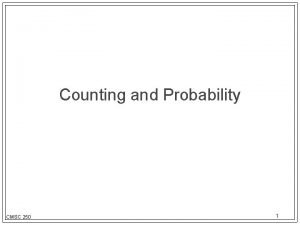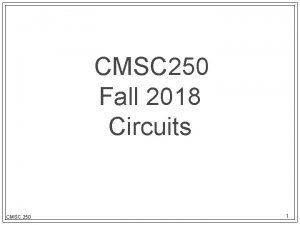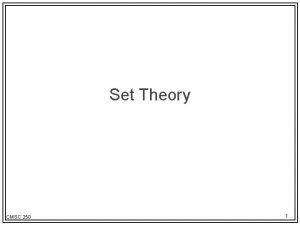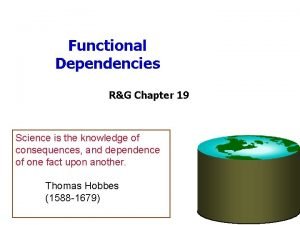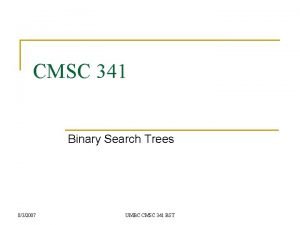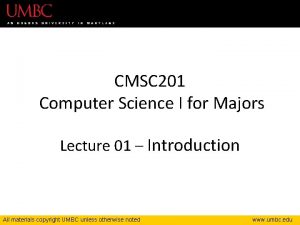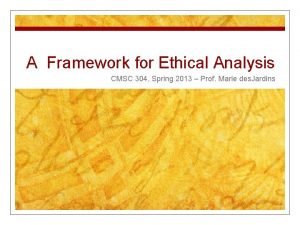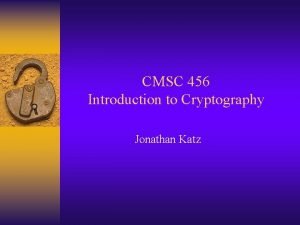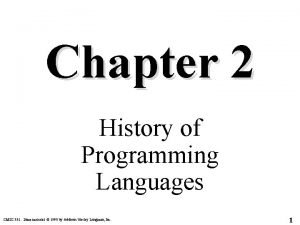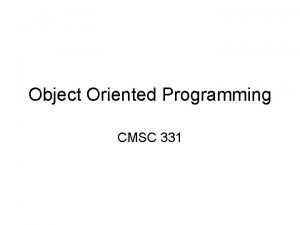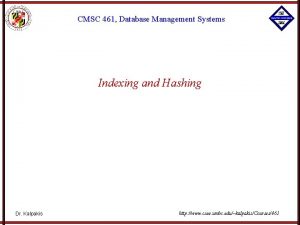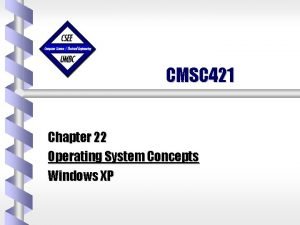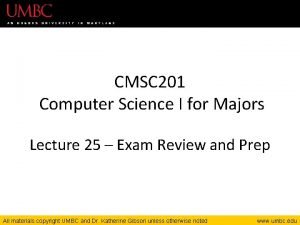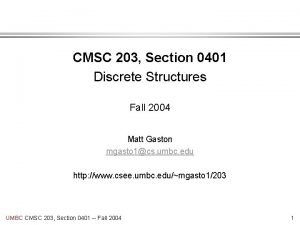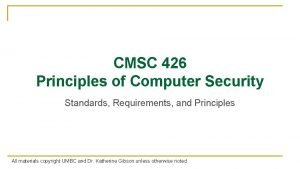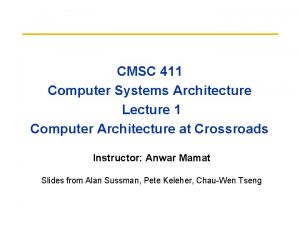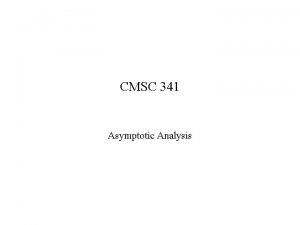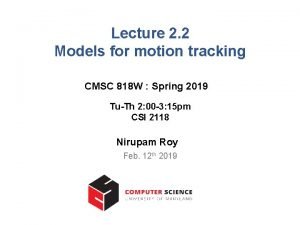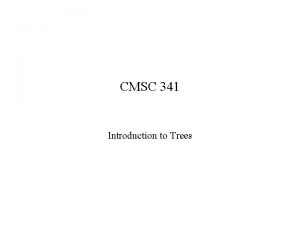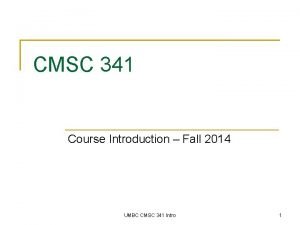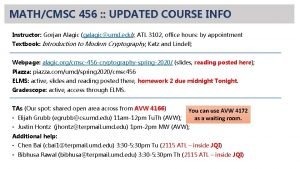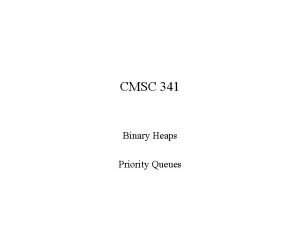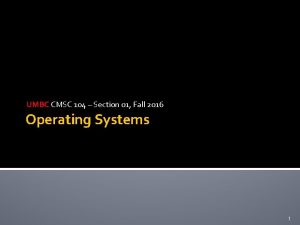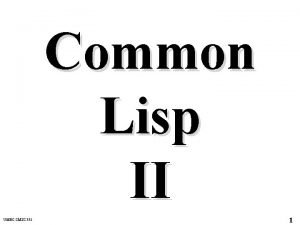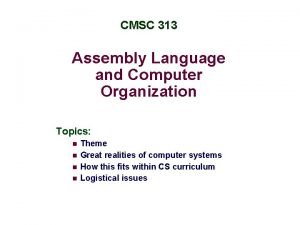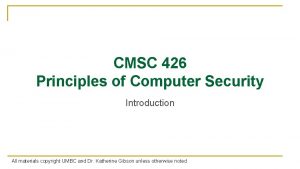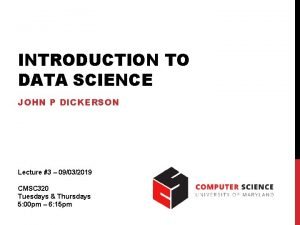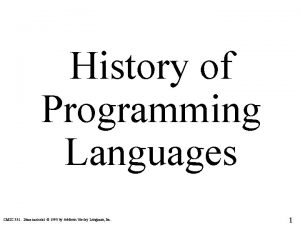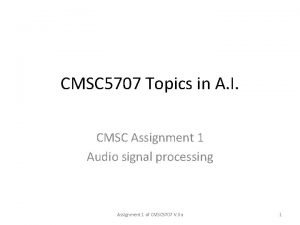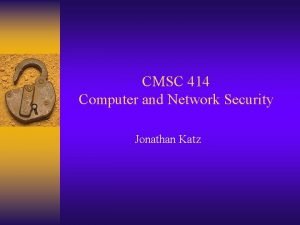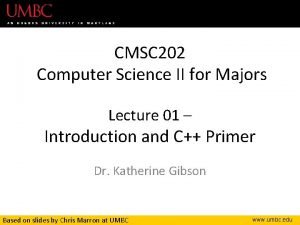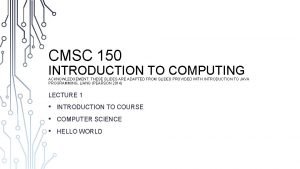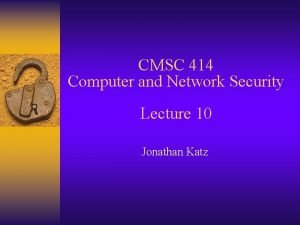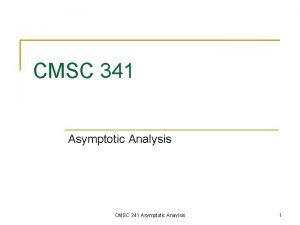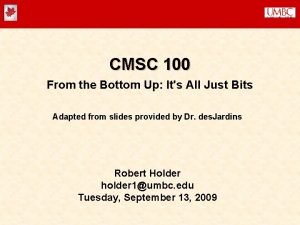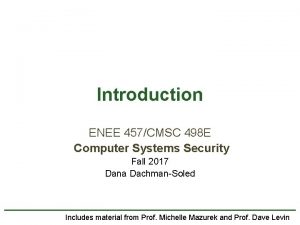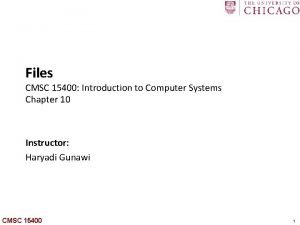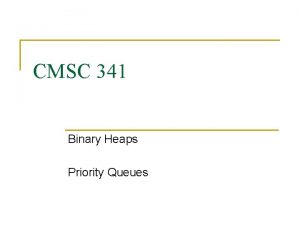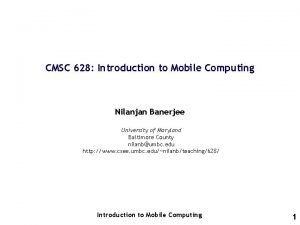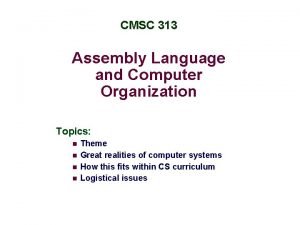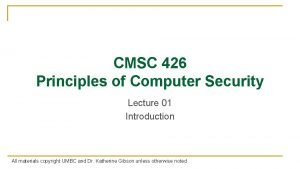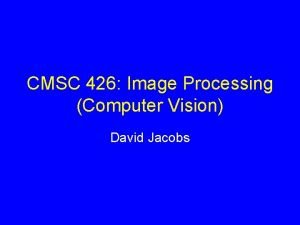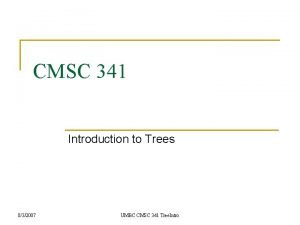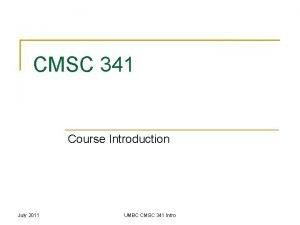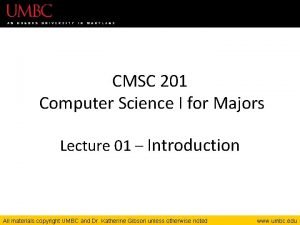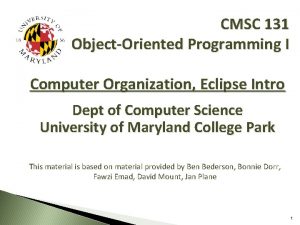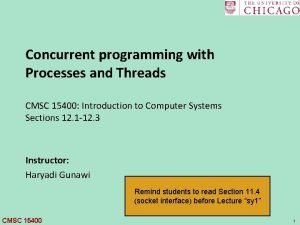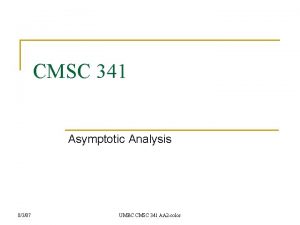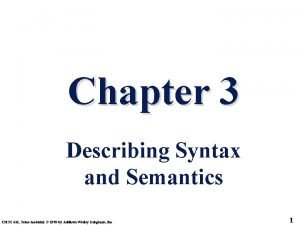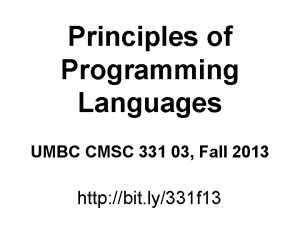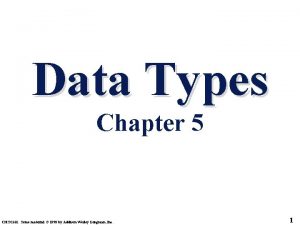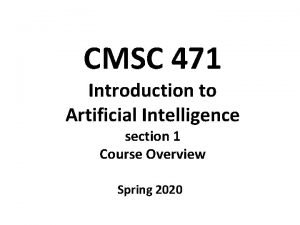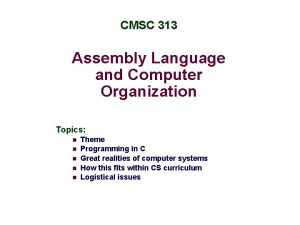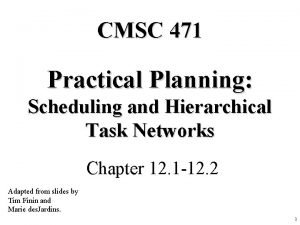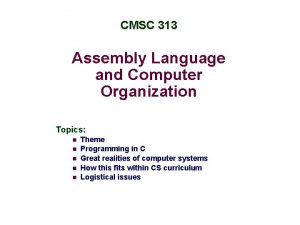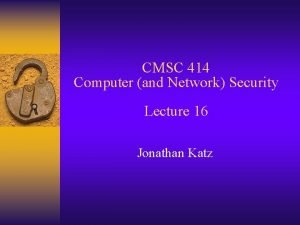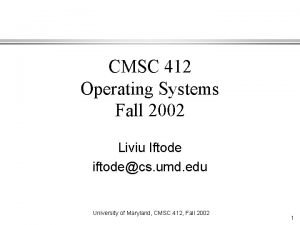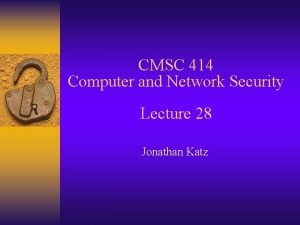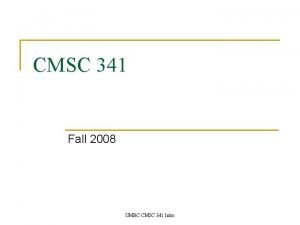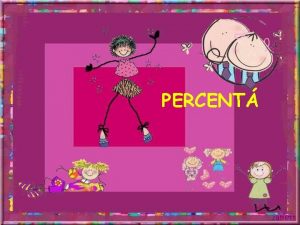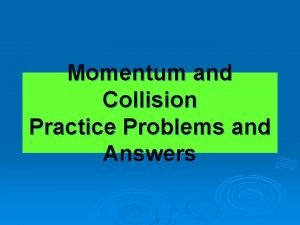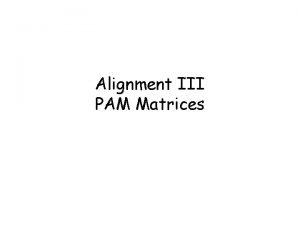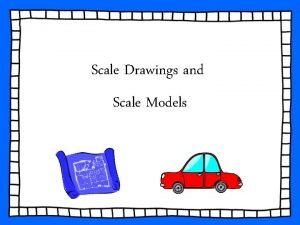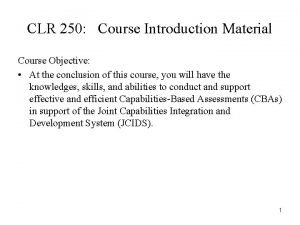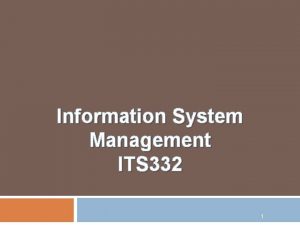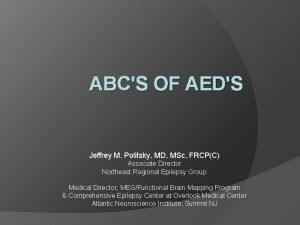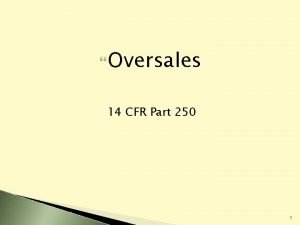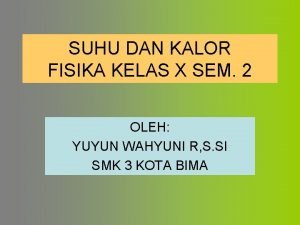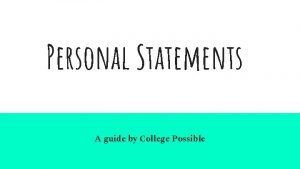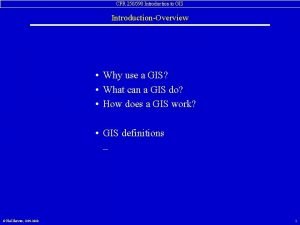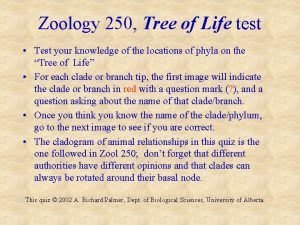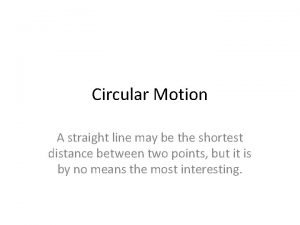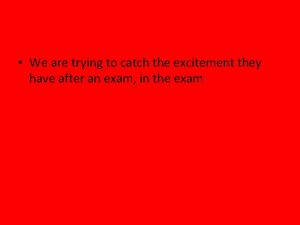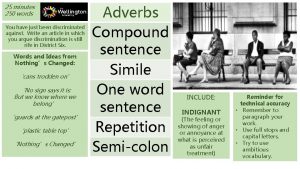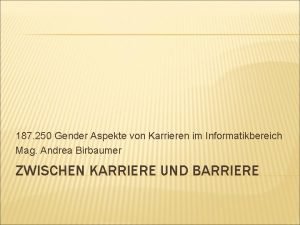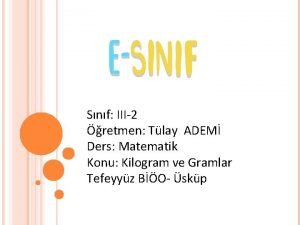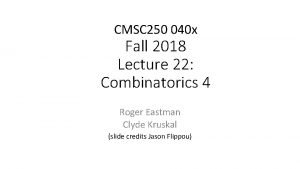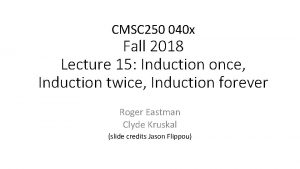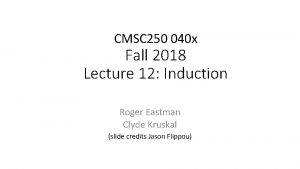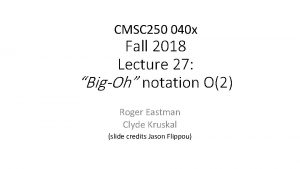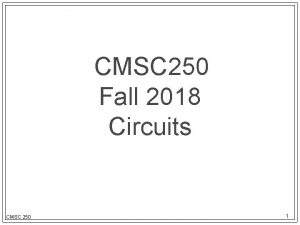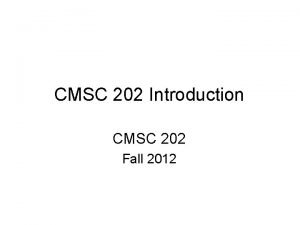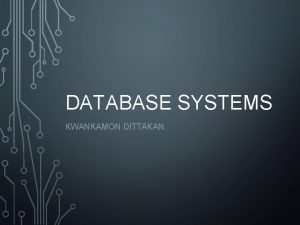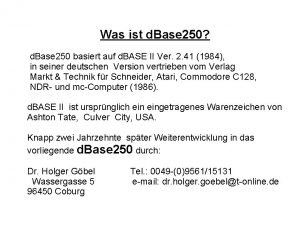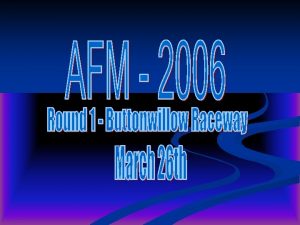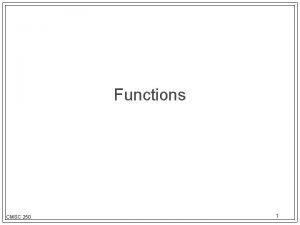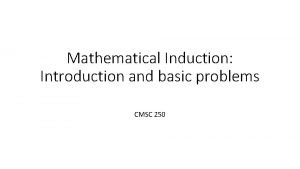CMSC 250 040 x Fall 2018 Lecture 24






























































































































- Slides: 126

CMSC 250 040 x Fall 2018 Lecture 24: Probability Roger Eastman Clyde Kruskal (slide credits Jason Flippou)

Informal definition of probability •

Informal definition of probability •

First examples • Experiment #1: Tossing the same coin 3 times.

First examples • Experiment #1: Tossing the same coin 3 times. • What is the probability that I don’t get any heads? Something else

First examples • Something else

First examples • Something else Implicit assumption: all individual outcomes (HHH, HHT, HTH, …. ) are considered equally likely (probability 1/8)

Practice • Experiment #2: I roll two dice. • Probability that I hit seven = ? Something else

Practice • Something else

Practice • Something else

Practice • Something else

Poker Practice • Full deck = 52 cards, 13 of each suit:

Poker redux • Next sequence does poker hands • Will review quickly, stopping only for a few points

Poker Practice • Full deck = 52 cards, 13 of each suit: • Flush: 5 cards of the same suit • What is the probability of getting a flush?

Probability of a flush • How many 5 -card hands are there?

Probability of a flush •

Probability of a flush •

Probability of a flush •

Probability of a flush •

Probability of a flush •

Probability of a flush •

Probability of a flush •

Probability of a flush •

Probability of a flush •

Likelihood of a straight • Straights are 5 cards of consecutive rank • Ace can be either end (high or low) • No wrap-arounds (e. g Q K A 2 3, suits don’t matter) • What is the probability that we are dealt a straight?

Likelihood of a straight •

Likelihood of a straight •

Likelihood of a straight •

Caveat on flushes • Wikipedia says we’re wrong about flushes! • Formally, our flushes included (for example) 3 h 4 h 5 h 6 h 7 h • Hands like these are called straight flushes and Wikipedia does not include them.

Caveat on flushes • Wikipedia says we’re wrong about flushes! • Formally, our flushes included (for example) 3 h 4 h 5 h 6 h 7 h • Hands like these are called straight flushes and Wikipedia does not include them. • How many straight flushes are there?

Caveat on flushes • Wikipedia says we’re wrong about flushes! • Formally, our flushes included (for example) 3 h 4 h 5 h 6 h 7 h • Hands like these are called straight flushes and Wikipedia does not include them. • How many straight flushes are there? • 40. Here’s why: • Pick rank: A through 10 (higher ranks don’t allow straights) in 10 ways • Pick suit in 4 ways

Probability of non-straight flush… • This is how Wikipedia defines the probability of a flush.

Probability of a straight flush…

Probability of a straight flush…

Same caveat for straights •

Same caveat •

• Try to calculate the probability of a pair!




• Is this accurate? Yes No

• Severe Is this accurate? overcount! Yes No

Don’t count better hands! • In the computation before, we included: • 3 -of-a-kind • 4 -of-a-kind • etc • To properly compute, we would have to subtract all better hands possible with at least one pair.

Joint probability (“AND” of two events) •

Calculating joints • Probability that the first coin toss is heads and the second coin toss is tails

Calculating joints • Probability that the first coin toss is heads and the second coin toss is tails

Calculating joints • Probability that the first coin toss is heads and the second coin toss is tails • Probability that the first die is at most a 2 and the second one is 5 or 6

Calculating joints •

Calculating joints •

Calculating joints • Roger’s going to flip a coin and then pick a card from a 52 -card deck. • Probability that the coin is heads and the card is 8? Something else

Calculating joints • Something else

The law of joint probability •

The law of joint probability •

Calculating joints of dependent events • Probability that a die is even and that it is 2.

Calculating joints of dependent events •

Calculating joints of dependent events •

Calculating joints of dependent events •

Calculating joints of dependent events •

Calculating joints of dependent events •

Set-theoretic interpretation • 1 6 3 4 2 • Die roll even • Die roll comes 2 5

Calculating joints • The University of Southern North Dakota offers a Discrete Mathematics Course where the possible grades are A through G. (No + or -) • What is the probability that Jason gets both an A and a G in that course?

Calculating joints •

Calculating joints •

Calculating joints •

Calculating joints •

Set-theoretic interpretation • A G

Calculating joints •

Calculating joints •

Calculating joints •

Set-theoretic interpretation • Let A = dice comes up 1, 2, or 3 • Let B = dice comes up 3, 4, or 5 • Let C = dice comes up 1, 2, 3, 4, 5 OR 6 1 4 A 2 3 C B 5 6

Set-theoretic interpretation • 1 4 A 2 3 C B 5 6

Independent events (informally) • Two events are independent if one does not influence the other. • Examples: • The event E 1 = “first coin toss” and E 2 = “second coin toss” • With the same die, the events E 1 = “roll 1”, E 2 = “roll 2”, E 3 = “roll 3” • Rogerflips a coin and then picks a card. • Counter-examples: • E 1 = “Die is even”, E 2=“Die is 6” • E 1= “Grade in 250” and “Passing 250”

Law of joint probability (informally) •

Disjoint or independent? Disjoint Independent Both Neither

Disjoint or independent? Disjoint Independent Both Neither Weather is weird!

Disjoint or independent? Disjoint Independent Both Neither Weather is weird!

Disjoint or independent? Disjoint Independent Both Neither Weather is weird!

Disjoint or independent? Disjoint Independent Both Neither Weather is weird!

Disjoint or independent? Disjoint Independent Both Neither Weather is weird!

Disjoint or independent? Disjoint Independent Both Neither Weather is weird!

Disjoint or independent? Disjoint Independent Both Neither Weather is weird!

Disjoint Probability (“OR” of two events) •

Disjoint probability (“OR”) • 52 -card deck • Probability of drawing a face card (J, Q, K) or a heart

Disjoint probability (“OR”) • 52 -card deck • Probability of drawing a face card (J, Q, K) or a heart • Are these disjoint?

Disjoint probability (“OR”) •

Disjoint probability (“OR”) •

Disjoint probability (“OR”) •

Alternative viewpoint •

Probability of unions •

Probability of unions of 3 sets •

Recap: “Disjoint” vs “independent” • Friends don’t let friends get confused between “disjoint” and “independent”! Disjoint Independent Has a set-theoretic interpretation! Has a causality interpretation!

Conditional Probability • If A occurs, then is B a) More likely? b) Equally likely? c) Less likely?

Conditional Probability • If A occurs, then is B a) More likely? b) Equally likely? c) Less likely? • Any of these could happen, it depends on the relationship between A and B.

Conditional Probability • If A occurs, then is B a) More likely? b) Equally likely? c) Less likely? • Any of these could happen, it depends on the relationship between A and B. OR OR OR …

Examples •

Examples •

Examples • What is the probability of A given B?

Examples • What is the probability of A given B? • Outcomes of A are (1, 3), (2, 2), (3, 1), (2, 6), (3, 5), (4, 4), (5, 3), (6, 2), (6, 6) • Outcomes of B are (3, 1), (3, 2), (3, 3), (3, 4), (3, 5), (3, 6) • Outcomes of rolling two die: (1, 1), (1, 2), …. , (6, 5), (6, 6)

Examples • What is the probability of A given B? • Outcomes of A are (1, 3), (2, 2), (3, 1), (2, 6), (3, 5), (4, 4), (5, 3), (6, 2), (6, 6) • Outcomes of B are (3, 1), (3, 2), (3, 3), (3, 4), (3, 5), (3, 6) • Outcomes of rolling two dice: (1, 1), (1, 2), …. , (6, 5), (6, 6)

Examples •

Examples •

Examples •

Examples •

Examples •

Examples •

Examples • Go up Go down Stay the same Unknown to science

Examples • Go up Go down Stay the same Unknown to science Let’s see if your intuition was correct!

Examples •

Examples •

Examples •

Examples • Go up Go down Stay the same Unknown to science

Conditional probability •

Re-thinking independent events •

Re-thinking independent events •

Complex probabilities •

Complex probabilities •

Complex probabilities •

Complex probabilities •

Complex probabilities • Go up Go down Stay the same

Complex probabilities • Go up Go down Stay the same Let’s see if your intuition was correct!

Complex probabilities •

Questions • Yes No

Questions • Yes No

Questions • Yes No A ind B iff B ind A

Questions • Yes No

Questions • Yes No
 Cmsc 250
Cmsc 250 Cmsc 250
Cmsc 250 Cmsc250
Cmsc250 Cmsc 250
Cmsc 250 Xeno kovah
Xeno kovah 040 231 3666
040 231 3666 Rodozměna kapradin
Rodozměna kapradin 040 9237242
040 9237242 Imex tmc 040
Imex tmc 040 01:640:244 lecture notes - lecture 15: plat, idah, farad
01:640:244 lecture notes - lecture 15: plat, idah, farad Dada la siguiente secuencia rusia 2018 rusia 2018
Dada la siguiente secuencia rusia 2018 rusia 2018 Umbc cmsc 341
Umbc cmsc 341 Cmsc 201
Cmsc 201 Cmsc 304 umbc
Cmsc 304 umbc Cmsc 417
Cmsc 417 Cmsc335
Cmsc335 Cmsc 456 3 cryptology
Cmsc 456 3 cryptology Cmsc 331
Cmsc 331 Cmsc 331
Cmsc 331 Cmsc 417
Cmsc 417 Cmsc 421 umbc
Cmsc 421 umbc Cmsc 461
Cmsc 461 Cmsc 421
Cmsc 421 Cmsc 201
Cmsc 201 Cmsc 421 umbc
Cmsc 421 umbc Cmsc 426
Cmsc 426 Cmsc 411 umd
Cmsc 411 umd Cmsc 341
Cmsc 341 Tracking cmsc
Tracking cmsc Cmsc 341
Cmsc 341 Umbc cmsc 341
Umbc cmsc 341 Cmsc 456 3 cryptology
Cmsc 456 3 cryptology Cmsc 341
Cmsc 341 Apple notes
Apple notes Cmsc 331
Cmsc 331 Cmsc 313
Cmsc 313 Cmsc 426 umbc
Cmsc 426 umbc Cmsc 320 github
Cmsc 320 github Cmsc 331
Cmsc 331 Cmsc5707
Cmsc5707 Cmsc414 umd
Cmsc414 umd Cmsc 202
Cmsc 202 Cmsc 150
Cmsc 150 Cmsc 414
Cmsc 414 Cmsc 341
Cmsc 341 Cmsc100
Cmsc100 Cmsc 457
Cmsc 457 Cmsc 335
Cmsc 335 Cmsc 435
Cmsc 435 Cmsc417
Cmsc417 Cmsc 15400
Cmsc 15400 Cmsc 341
Cmsc 341 Cmsc 131
Cmsc 131 Cmsc phone number
Cmsc phone number Cmsc 313
Cmsc 313 Cmsc 426 umbc
Cmsc 426 umbc Cmsc426
Cmsc426 Cmsc 5707
Cmsc 5707 Cmsc 341
Cmsc 341 Cmsc 203 umbc
Cmsc 203 umbc Cmsc 201 umbc
Cmsc 201 umbc Cmsc 131
Cmsc 131 Cmsc 15400
Cmsc 15400 Cmsc 341 umbc
Cmsc 341 umbc Cmsc250 umd
Cmsc250 umd Cmsc 331
Cmsc 331 Cmsc 331 umbc
Cmsc 331 umbc Cmsc 331
Cmsc 331 Cmsc 131
Cmsc 131 Cmsc471
Cmsc471 Cmsc 417
Cmsc 417 Cmsc 313
Cmsc 313 Cmsc 471
Cmsc 471 Umbc cmsc 313
Umbc cmsc 313 Cmsc 414
Cmsc 414 Liviu iftode
Liviu iftode Cmsc 414
Cmsc 414 Umbc cmsc 341
Umbc cmsc 341 Ess 250
Ess 250 1% z 250
1% z 250 A snowmobile has a mass of 250 kg
A snowmobile has a mass of 250 kg Gli 250
Gli 250 Pam250 scoring matrix
Pam250 scoring matrix August lec 250
August lec 250 Ece 222 github
Ece 222 github Kelly enlarged the area of a photograph to 250
Kelly enlarged the area of a photograph to 250 Pounds to kg equation
Pounds to kg equation Ece 250
Ece 250 Ece 250
Ece 250 750 yuvarlanabilecek sayılar
750 yuvarlanabilecek sayılar Amd bc-250
Amd bc-250 Asl unit 5
Asl unit 5 Clr 250
Clr 250 250 word paragraph
250 word paragraph Isp 250 uitm
Isp 250 uitm Diamox 250
Diamox 250 Echelle textuelle
Echelle textuelle Bosch mot 250
Bosch mot 250 Verjans signalisatie
Verjans signalisatie Liedboek 416
Liedboek 416 Sgc 250
Sgc 250 Sensibilità becher
Sensibilità becher 30 cfr part 250
30 cfr part 250 250-544-7600
250-544-7600 Sebuah plat baja berbentuk persegi dengan sisi 30 cm
Sebuah plat baja berbentuk persegi dengan sisi 30 cm 250 square root
250 square root Glycomet 250 sr
Glycomet 250 sr Ece250
Ece250 Prime numbers chart
Prime numbers chart 250 word essay length
250 word essay length Calprotectine betekenis
Calprotectine betekenis Cfr 250
Cfr 250 Zool 250
Zool 250 Dos 28 bombons que estavam na minha gaveta
Dos 28 bombons que estavam na minha gaveta Dave paige
Dave paige Location and layout of hospital pharmacy
Location and layout of hospital pharmacy Billions8
Billions8 A 250 kg motorcycle is driven around a 12 meter tall
A 250 kg motorcycle is driven around a 12 meter tall Phys 250 ubc
Phys 250 ubc 200 250 words
200 250 words 250 words in minutes
250 words in minutes Cm 250/85 sintesi
Cm 250/85 sintesi Um trenó com massa total de 250 kg desliza no gelo
Um trenó com massa total de 250 kg desliza no gelo 187/250
187/250 Kütlesi 250 gram olan elma 1 kilogram dan ne kadar azdır
Kütlesi 250 gram olan elma 1 kilogram dan ne kadar azdır Ez-guide 250
Ez-guide 250 120000/250
120000/250
